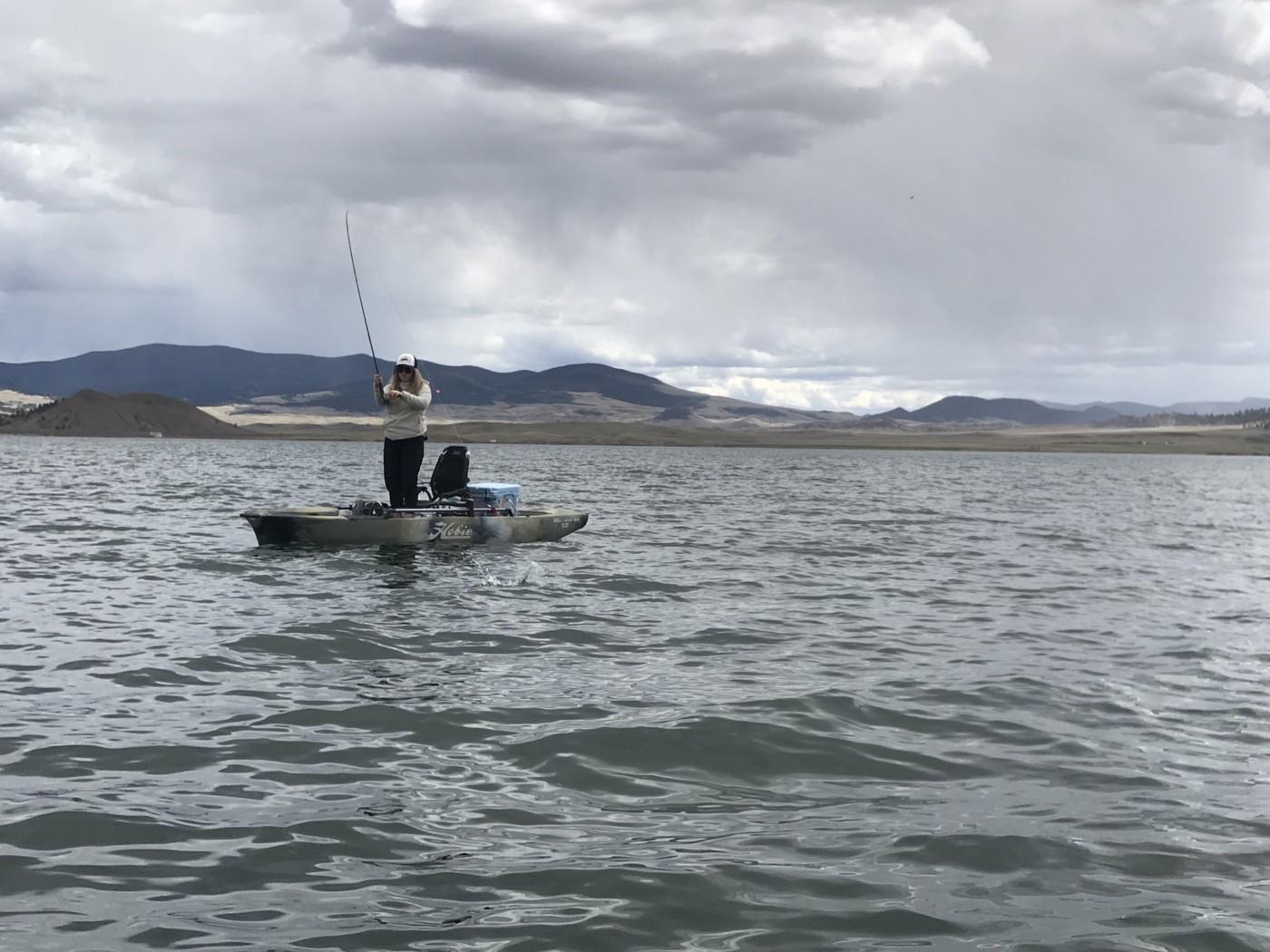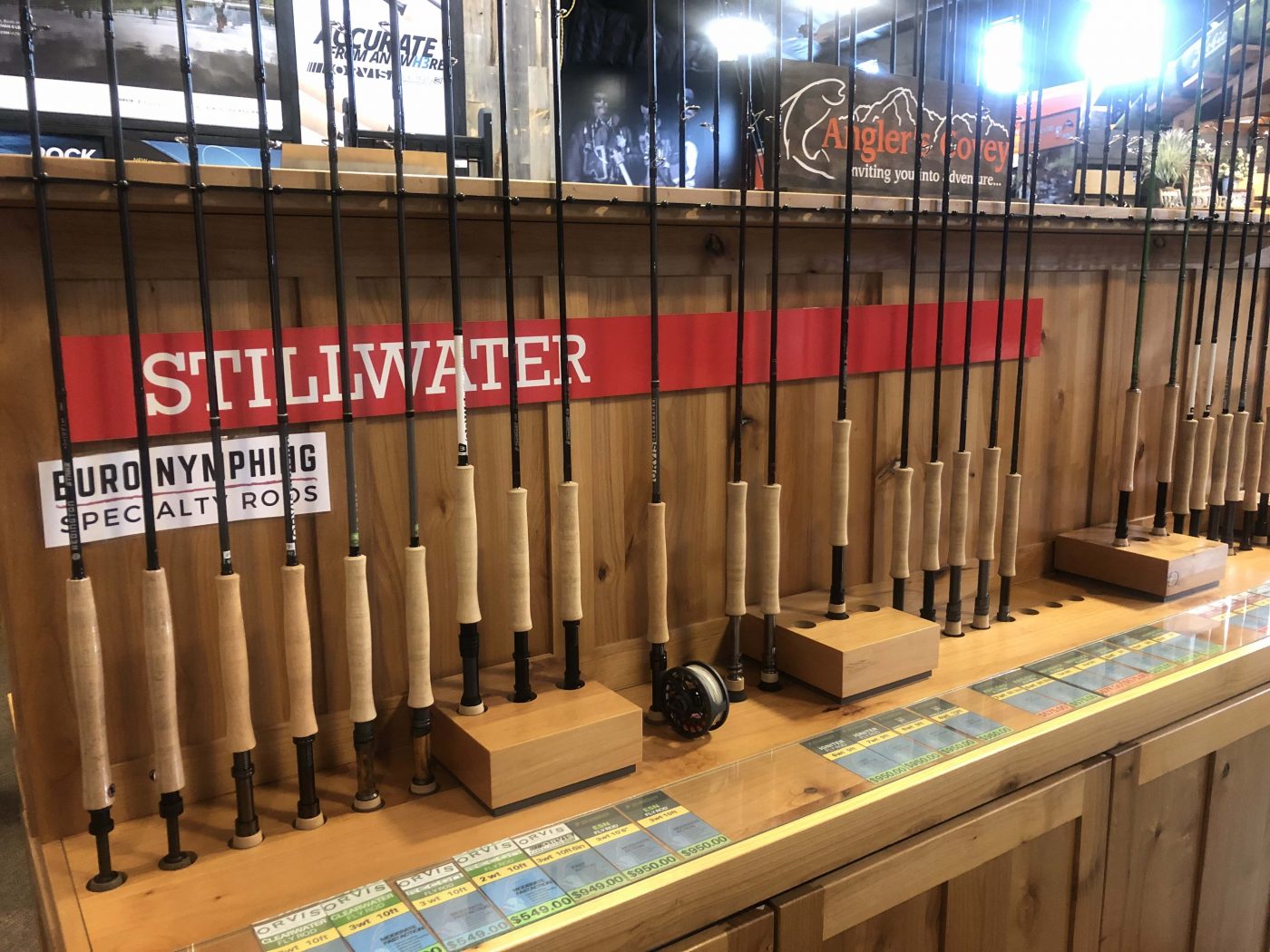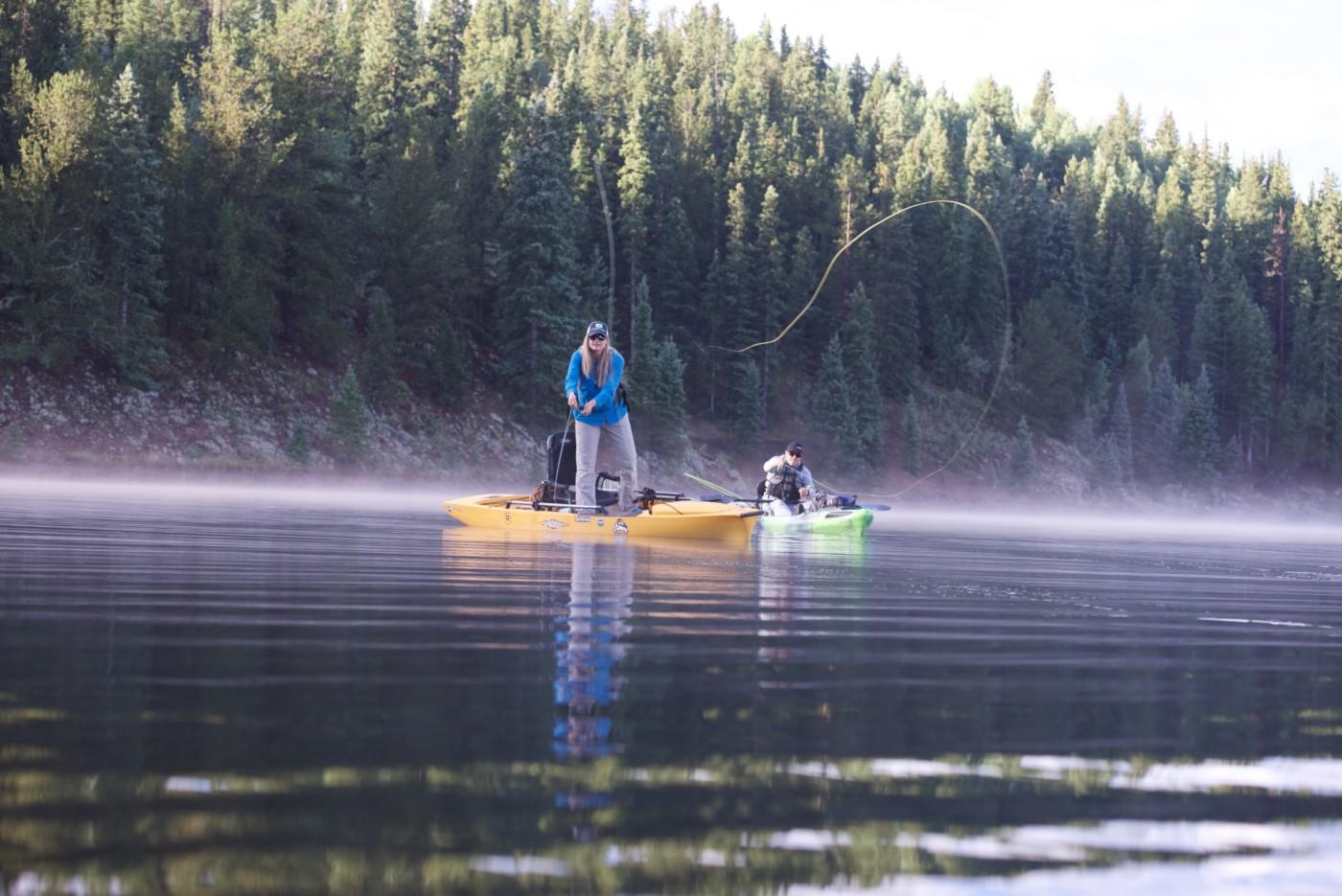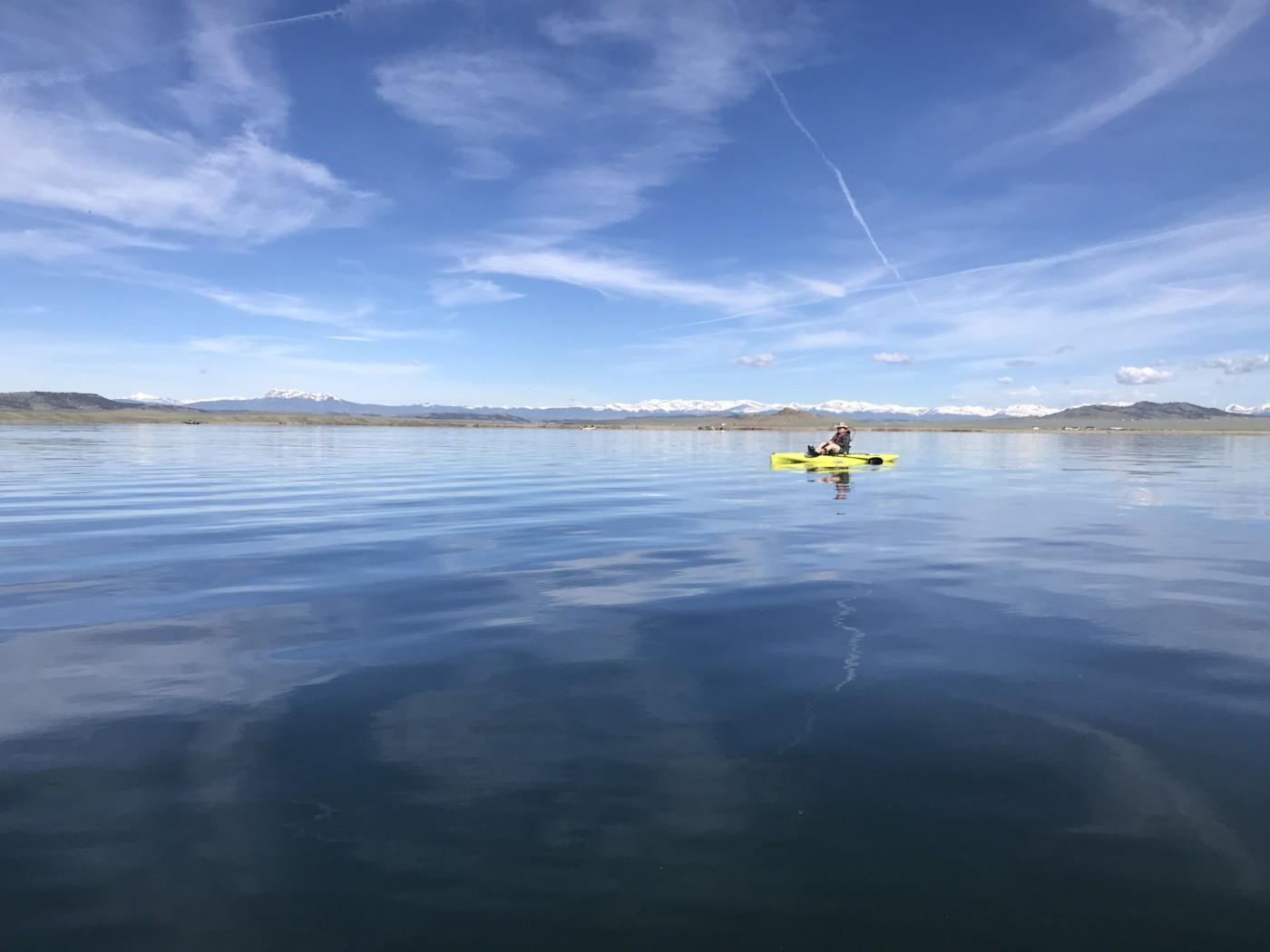Stillwater Fly Fishing Gear: Grow Your Adventure
Stillwater is often the overlooked, under-utilized resource when it comes to this fly fishing adventure. And it’s sort of a sad fact. As Kenny Romero, one of our guides, says, “you’re missing the boat (pun intended) if you’re not exploring stillwater fly fishing.” It will push you out of your comfort zone, for sure, but we know what that means: more risk, bigger reward. Here is Part One of our round-table on stillwater fly fishing with guides and our retail staff giving the low-down on stillwater gear.
Throughout this season, we will have blog entries that focus on different aspects of stillwater fly fishing. First up, what to look for in essential gear. Next week, we’ll focus on early season patterns to use and techniques.

If an angler chooses to just use a 9′ 5 wt — what are advantages / disadvantages for stillwater fly fishing?
Jon Easdon, Director of Services, Guide: While you can certainly use a standard 9′ 5 wt rod, it’s not ideal. It will get the job done, but there are much better options out there for stillwater.
Jared Sanders, Retail Shift Manager and Guide: The only real advantage is that you don’t have to buy another set-up and you’re aleady used to casting that rod and reel. The big disadvantage is if you have a heavy nymph set up, or maybe you want to cast that set up further out, you will have difficulty casting a 5 weight line. It doesn’t have the weight to carry that effectively. Same with streamers, particularly if you are going to fish a sink tip line. It’s really tough to get that line out with a 5 weight. You could make the 9 ft 5 wt a dry fly rod for fishing dries on on Spinney, Elevenmile and Antero.
What if budget is a consideration?
Jon: The great thing about fly fishing, in general, these days is there are a lot of budget-minded products out. You don’t have to spend a ton of money to get a serviceable set up. In order of importance, spend the money on good fly lines, as they can make or break your set up. Second would be reels, and again focusing on a reel with a good sealed drag. Rod selection would be last.

If an angler wants to set up a stillwater fly fishing combo specifically, what sorts of things should the angler consider? Let’s start with lines.
Jon: Fly lines can also get complex in this scenario too. If you want to keep it simple, A standard WF floating line will cover most bases. For me personally, I have 3 different systems that I fish on stillwater that require different fly lines.
First, with a standard WF floating line Ill use for my dry fly, dry/dropper, and static nymph rigs. I like heavier headed lines like power tapers or nymph specific lines. Again, these will help in casting and in turnover.
Second, I like a type 1 intermediate sink line. This is a system that I have been using more and more for slow stripping or crawling nymphs and is my go to. These lines will drop your offering down around 2 feet below the surface. Which is in fact where the majority of fish like to feed.
And lastly, I like type 2 or 3 sink lines for throwing big meaty streamers for trout and pike.These lines are heavy and get that fly down quick.
We also use way heavier terminal tackle like 0x-3x. You have to remember that fish in stillwater fight a lot different than their river run brothers and are not generally “tippet shy.” For toothy critters I will also use a wire leader or wire tippet.
What are some particular brands of lines I should consider?
Jared: When it comes to lines, you’re going to be casting a bigger rig a longer distance and you need a line that is a little on the heavy side to help carry that. For fly lines to be effective in stillwater, the taper is heavier in the front. The Big Nasty is meant for big flies, for big indicator rigs and are meant to carry big bugs. Stillwater Floater is another. It has a different taper to really shoot that line out further. Especially, too, if wind is at play the extra weight will help you shoot that line out.
Angel Cruz, Shift Manager: I like the Rio Stillwater Floaters. The longer heads help with turning over the heavier indicator rigs. If you’re fishing from the banks, in a lot of situations, you’re not going to have a lot of back cast room, so longer head lines will make that roll-cast just a little easier. Most are a pretty good shooting line, so if you have to cast far, these will do that – if you need to make some overhead false casts and then bomb some line out.
All of the guys agreed that budget, personal preferences, and type of fishing are factors. Come into the shop and discuss what line might be the best for your goals.
How about reels? What are the look-fors in selecting reels dedicated to stillwater fly fishing?
Jon: For the reel, I like large or extra large arbor reels with a good drag. Some fish in the reservoirs will take you into your backing. It’s important to have a reel that will recover line quickly and a good drag to keep up with the fight.
Jared: When considering reels, a nice drag system and large arbor are key points to look out for. You need a reel with good drag and with good construction. These fish are bigger than your average trout in the river.
You want a reel that is durable and that will put the brakes on those fish. When they go for a long run, you have to make them work. And there are no barriers, “no walls,” as Jon says, in stillwater. They have all their energy. They’re not fighting the current. When they fight, they fight hard.
Large arbor helps, too, so when you get a nice fish, you can reel in a lot of line effectively.
Angel: The larger arbor gives me faster line pickup. When those fish have “no walls,” they go deep. They dive straight down and get into the junk when the weeds get high late in the summer.
Having an extra inch of line retrieved per crank makes a difference. When the fish are dive bombing to the bottom. And in the summer, when the water is warming, you want less of a fight to keep fish healthy. If I can minimize the fight and winch them in, so to speak, I would prefer that.

So let’s talk about rods.
Jon: 10 foot rods definitely come into play. I like to beef up the rod size as well into a 6 or 7 weight rod. Leaning towards fast or moderate fast action rods will also help. The additional length is going to assist in longer roll casts and increased control while mending and fighting fish.
This will also help you throw heavier and longer rigs. Something common in stillwater fly fishing. The additional length and increased rod size is also clutch in windy conditions.
Jared: A longer rod will help you get more line out for a longer cast.
For setting and managing line, a longer rod is more ideal. For nymphing and an indicator rig, a 9.6 or 10 ft rod makes setting easier. If you have 50 or 60 feet of line out, and leader attached to your flies, everything in that rig stretches when you set. Your line, leader, tippet all stretches. That extra length on the rod captures that stretch and helps you get a better set on the fish. Need a heavy rod to set and capture that stretch.
Angel: I prefer a longer rod. Allows you to reach more distance. Extra length means more distance. and gives you more leverage. Turning over larger indicator rigs. 9’6” 6 weight. 10 foot 6 or 7 weight. The Sage X 10’ 6 wt is a phenomenal rod. The Ignitor kicks it up a notch in terms of speed of the rod.
You’ll also be fighting the wind. Later into the spring and into the summer, those afternoon storms get a lot of people. Their 4 and 5 weights make it tough when the wind picks up and there is more chop. Having the ability to put on some more weight, get it out, and let it sink. With the wind and the water all churned up, the flies have to get down.
Jon: For predatory fish such as Northern Pike, I like a standard 9-foot rod in either an 8 or 9 weight. Again, these heavier rods will allow the angler to cast larger flies and put more “wood” to the fish they are fighting.
So what are some rod-reel combos I might consider.
Jared: For the budget-minded angler but one who wants to have a dedicated stillwater rig, there are some great options at different price points. Orvis’s Clearwater has a great selection of lengths and weights (10 ft 5 wt; 9.5 ft 6 wt; 10 ft 6 wt). You might even step up to a 7 wt for throwing streamers or for a meaty-ier indicator set up.
For a Clearwater 9.6 ft 6 wt., the Clearwater reel has a decent enough drag to put some work on that fish and stop them. The Orvis Hydros is the next price point up for a quality rod.
The Redington Vice, 9’6” ft. 6 wt, is a very versatile stillwater rod. You can throw dries with it, heavy indicator rigs; throw streamers. It’ll cast just about anything really well. You can use this rod for both stillwater and a streamer rod for river fishing. Pair the Redington Behemoth with the Vice and you would have a great set up.
Angel: I like the 7 wt Nautilus reel. The Redington Run is a great reel option. The Orvis Mirage is a higher price point, but a great reel coupled with the Hydros.
Come into the shop and talk with our team about all the options when considering your stillwater fishing set up!
What’s ahead?
As we move toward Opening Day at Spinney, consider adding that stillwater rig to your arsenal of tools. We will look at Early Season techniques and patterns next week – basically from Ice-off to Early June. As we get further into the season, we’ll explore the stillwater season of June through October 1. In the fall, we’ll look at patterns and techniques for late season stillwater fly fishing from October 1 through November 15.
Over the next couple of weeks, we’ll hear from Phil Terelya and fishing the easily accessible lakes around Colorado. We’ll get in-depth patterns and technique updates from Kenny Romero – who considers stillwater fishing one of his passions. And we want to hear from you, too. Watch this space and our Facebook and Instagram feeds for ways you can share your stillwater experiences with us.

Jon Easdon will be teaching his class, “Kayak Fly Fishing Colorado’s Trophy Trout Lakes,” on April 15 from 6:00 pm to 8:00 pm on April 15. Register for that class here.
Kenny Romero will be teaching his stillwater classes this spring, too. Watch this blog or sign up for our newsletter to know when those dates are on the calendar!
Read about our Guided Stillwater Fly Fishing Trip here.

Liked all the info. I’m a saltwater guy but like to read about different aspects of fishing that I may apply to my area.
I have been fly fishing from a kayak and/or canoe on high elevation lakes in Colorado for over 30 years. As a ranger on the North Slope of Pikes Peak I have been asked these questions that John, Jared, Angel and others at the shop have answered and thoroughly agree with them. This shop is a great source of information as well as equipment.
As a stillwater fly fishing guide, a 10’ to 10.5’ rod is a must. All my clients can throw a WFF fly line but have a challenge throwing sinking line therefore I use a Intermediate line.
Nice article and well written.